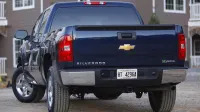How new CAFE rules will force pickup trucks to get cleaner

When it comes to “hybrid electric and other advanced technologies in full-size pickup trucks,” the new CAFE rules also offer some incentives, but the details are not yet decided. The general idea, though, is that trucks will have to get cleaner, just not as fast as cars do.
Speaking to reporters when the new rules were finalized, EPA administrator Lisa Jackson said the difference in economy requirements between cars and trucks mean there are steeper reductions in early years for cars than there are for trucks, because improving the fuel economy for trucks will take a bit longer and the administration did not want to affect work performance for the trucks while pushing them to burn less fuel. The EPA document (PDF) says:
EPA is providing a per-vehicle CO2 credit in the GHG program and an equivalent fuel consumption improvement value in the CAFE program for manufacturers that sell significant numbers of large pickup trucks that are mild or strong hybrid electric vehicles (HEVs). To qualify for these incentives, a truck must meet minimum criteria for bed size, and for towing or payload capability (page 58).
There are more details:
Consistent with the proposal, for passenger cars, the CO2 compliance values associated with the footprint curves will be reduced on average by 5 percent per year from the model year 2016 projected passenger car industry-wide compliance level through model year 2025. … For light- duty trucks, the average annual rate of CO2 emissions reduction in model years 2017 through 2021 is 3.5 percent per year. As proposed, EPA is also changing the slopes of the CO2-footprint curves for light-duty trucks from those in the 2012-2016 rule, in a manner that effectively means that the annual rate of improvement for smaller light-duty trucks in model years 2017 through 2021 will be higher than 3.5 percent, and the annual rate of improvement for larger light-duty trucks over the same time period will be lower than 3.5 percent. For model years 2022 through 2025, EPA is finalizing an average annual rate of CO2 emissions reduction for light-duty trucks of 5 percent per year (page 36).
So, truck builders, you better get the technology figured out, but you’ve got a little bit of breathing room to do so.




